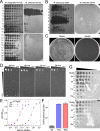Bacteriophage treatment of disseminated cutaneous Mycobacterium chelonae infection
- PMID: 35504908
- PMCID: PMC9064978
- DOI: 10.1038/s41467-022-29689-4
Bacteriophage treatment of disseminated cutaneous Mycobacterium chelonae infection
Abstract
Mycobacterium chelonae is a rare cause of chronic disseminated cutaneous infections in immunocompromised patients. Multidrug-resistant M. chelonae infections present a challenge for treatment, and prolonged antimicrobial courses lead to significant toxicities and further antimicrobial resistance. We report a case of refractory cutaneous disseminated M. chelonae infection in a patient with seronegative arthritis on immunotherapy with tofacitinib that was treated with combination antimicrobial, surgical, and single bacteriophage therapy with excellent clinical response. The patient developed neutralizing antibodies against the bacteriophage but continues to have stable improvement of disease with negative biopsies and no evidence of bacterial resistance to the phage.
© 2022. The Author(s).
Conflict of interest statement
C.A.B. receives contract and grant funding from Gilead. G.F.H. acts as consultant and grant recipient for Janssen pharmaceuticals. The remaining authors declare no competing interests.
Figures



Similar articles
-
Rapid development of resistance to clarithromycin following monotherapy for disseminated Mycobacterium chelonae infection in a heart transplant patient.Clin Infect Dis. 1995 Feb;20(2):443-4. doi: 10.1093/clinids/20.2.443. Clin Infect Dis. 1995. PMID: 7742453
-
Induction therapy with linezolid/clarithromycin combination for Mycobacterium chelonae skin infections in immunocompromised hosts.J Eur Acad Dermatol Venereol. 2016 Jan;30(1):101-5. doi: 10.1111/jdv.12965. Epub 2015 Feb 11. J Eur Acad Dermatol Venereol. 2016. PMID: 25677464
-
Clinical trial of clarithromycin for cutaneous (disseminated) infection due to Mycobacterium chelonae.Ann Intern Med. 1993 Sep 15;119(6):482-6. doi: 10.7326/0003-4819-119-6-199309150-00006. Ann Intern Med. 1993. PMID: 8357113 Clinical Trial.
-
Emergence of resistance to clarithromycin during treatment of disseminated cutaneous Mycobacterium chelonae infection: case report and literature review.J Infect. 2001 Oct;43(3):163-8. doi: 10.1053/jinf.2001.0880. J Infect. 2001. PMID: 11798252 Review.
-
Mycobacterium chelonae tenosynovitis of the hand.Semin Arthritis Rheum. 2004 Dec;34(3):617-22. doi: 10.1016/j.semarthrit.2004.06.002. Semin Arthritis Rheum. 2004. PMID: 15609266 Review.
Cited by
-
Optimizing bacteriophage treatment of resistant Pseudomonas.mSphere. 2024 Jul 30;9(7):e0070723. doi: 10.1128/msphere.00707-23. Epub 2024 Jun 27. mSphere. 2024. PMID: 38934592 Free PMC article.
-
Successful treatment of Keratitis caused by Mycobacterium chelonae and an overview of previous cases in Europe.Ann Clin Microbiol Antimicrob. 2024 Oct 9;23(1):92. doi: 10.1186/s12941-024-00752-w. Ann Clin Microbiol Antimicrob. 2024. PMID: 39385246 Free PMC article. Review.
-
Complete Genome Sequences of Four Mycobacteriophages Involved in Directed Evolution against Undisputed Mycobacterium abscessus Clinical Strains.Microorganisms. 2024 Feb 11;12(2):374. doi: 10.3390/microorganisms12020374. Microorganisms. 2024. PMID: 38399778 Free PMC article.
-
A Report of Two Uncommon Cases of Mycobacterium chelonae with Localized and Disseminated Skin and Soft Tissue Infection.Infect Dis Rep. 2025 Feb 8;17(1):13. doi: 10.3390/idr17010013. Infect Dis Rep. 2025. PMID: 39997465 Free PMC article.
-
The Safety and Efficacy of Phage Therapy for Infections in Cardiac and Peripheral Vascular Surgery: A Systematic Review.Antibiotics (Basel). 2023 Nov 30;12(12):1684. doi: 10.3390/antibiotics12121684. Antibiotics (Basel). 2023. PMID: 38136718 Free PMC article. Review.
References
-
- Wallace RJ, Brown BA, Onyi GO. Skin, soft tissue, and bone infections due to Mycobacterium chelonae chelonae: importance of prior corticosteroid therapy, frequency of disseminated infections, and resistance to oral antimicrobials other than clarithromycin. J. Infect. Dis. 1992;166:405–412. doi: 10.1093/infdis/166.2.405. - DOI - PubMed
Publication types
MeSH terms
Substances
Grants and funding
LinkOut - more resources
Full Text Sources
Other Literature Sources
Medical

